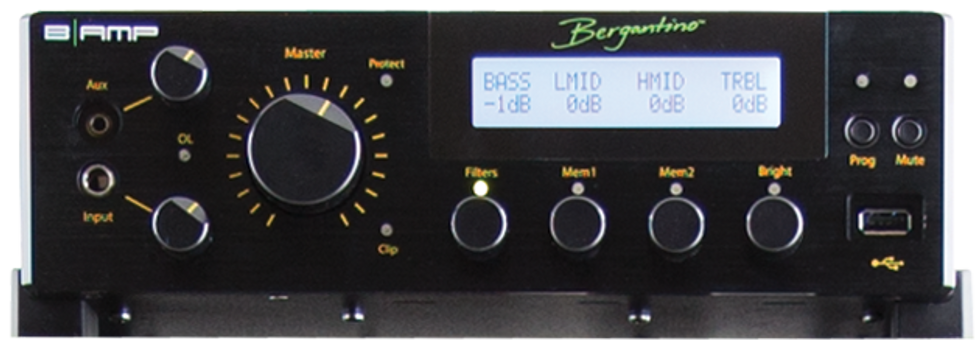Clip 1 - ’64 Fender Jazz bass. Amp EQ settings: +1 db @ 150 Hz, +1db @ 1.2 kHz
Clip 2 - Nash P-Style bass. Amp EQ set flat
Bergantino Audio Systems has garnered and maintained a solid reputation for their quality speaker cabinets since the company got its start in 2001. And an often-discussed subject by fans of the company’s cabs is what amplifiers pair best with Jim Bergantino’s designs. These dialogues, along with a growing cynicism towards modern-amp construction, compelled Bergantino to create the 700-watt B|Amp. His concept was to develop a unit that contained the essentials of tone sculpting and robust power, plus speaker profiles that EQ the response of different speaker enclosures. Bergantino provided us with both HD210 and HD112 cabinets for this review, but an HD212 and an additional HD112 from a personal collection were also utilized to check out a number of different speaker combinations.
Get with the Program
Thanks to digital technology, Bergantino was able to pack the 6-1/2 pound amp with features that could fill a medium-sized rack, and these options are organized in a thoughtful, intuitive configuration. Once a player sets the gain and master levels, the fun begins with the quintet of multifunctional controls underneath the LCD display.
The home screen displays the 4-band EQ and, here, the four knobs function as boost and cut controls. Pressing and holding any of the knobs switches the screen to the semi-parametric EQ section, where one can adjust the center frequency for each. Tapping any of the knobs brings you back to the home screen.
A quick push of the filters knob engages the variable feedback and high-pass filter section. These are extremely helpful for cleaning up muddy lows (as well as safeguarding your speakers) and mellowing out any feedback issues that plague some acoustic instruments. Conversely, tapping the bright/treble control engages the bright filter.
The bulk of the B|Amp’s features can be accessed through the program button, where I was able to sift through 13 different screens of tonal and operational functions. For instance, screen two displays the DI settings, while screen five displays information related to the USB input that allows installation of new speaker profiles or updates to the operating system. Screen seven sets the speaker load for safe operation at 2 ohms, 2.67 ohms, or 4/8 ohms. There’s even a screen that monitors the amplifier’s temperature and regulates fan control. There isn’t enough space here to detail all the screens and their respective functionality, but it’s safe to say this amp is packed. And while options of this magnitude might seem daunting at first, Bergantino’s interface is impressively intuitive.
I feel the most intriguing aspect of the B|Amp is the ability to “pre EQ” a particular speaker cabinet before any equalization takes place. To paraphrase Jim Bergantino, amp designers compromise their EQ settings to satisfy a wide range of cabinets. As a result, users make EQ adjustments that relate more to the deficiencies in the acoustic response of their cabinet, as opposed to their instrument’s tone. This likely explains why many a bassist will contend that a particular amp sounds much better with one type of speaker over another.
Bergantino’s solution lies within the profile section of the B|Amp. A twist of the filters knob reveals 12 speaker profiles (based on Bergantino’s models), which utilize precise filters to EQ different speaker configurations. This both maximizes speaker performance and minimizes excessive EQ adjustments.
Bergantino B|Amp Ratings
Pros:
A powerful, detailed amplifier packed with user-friendly options. Speaker profiles simplify sound sculpting.
Cons:
Control knobs lack a feeling of durability.
Tones:
Ease of Use:
Build/Design:
Value:

Street:
$1,399
Bergantino HD112 & HD210 Ratings
Pros:
Clean tone. Capable of handling a lot of power. Built like a tank.
Cons:
Boutique price.
Tones:
Versatility:
Build/Design:
Value:

Street:
HD112 ($729 street) & HD210 ($829 street)
Bergantino
bergantino.com
The HD210 and HD112 cabs provided for the review are ported, precision-tuned enclosures, constructed from high-quality Baltic birch. The woofers are comprised of ceramic drivers with vented pole pieces. Throw in a high-intelligibility tweeter, dress it all up in black tolex and a rigid, black grille, and you have a speaker cabinet with sleek styling that delivers crushingly clean tone.
Three Notes and the Truth
Initial tests were done by connecting the B|Amp to the HD210 and HD112 cabs, a speaker configuration reminiscent of a popular but discontinued Bergantino cab called the HD322. Once I plugged in a Sire Marcus Miller V7 4-string and diagnostics were completed, the muted amplifier engaged the tuner mode. The tuner isn’t as accurate as my Peterson strobe, but it could certainly come in handy for quick adjustments.
Once I disengaged the mute, I set the gain and turned up the master. After playing three notes, it was crystal clear that the Bergantino rig could produce full-bodied tone and had the capabilities of getting really loud. These impressions were intensified after adjusting the speaker profile to the HD322 setting. Within seconds, I heard (and felt) the enhancements provided by the filters that delivered a deep punch and a smoother transmission of the upper mids and highs. Replicating all of my technical idiosyncrasies with definition, the note response was quick.
I was curious to hear how the profile settings affected other Bergantino cabinets, so along with a fellow bassist, we added another HD112 and an HD212 to the mix. After a lengthy listening session with individual cabinets and different cab combinations, we were both impressed with how markedly the profile settings enhanced the characteristics of each cabinet. The HD210 profile increased upper mids and provided punchier lows, the HD112 profile delivered more midrange content, and the HD212 profile tightened up the lows with a slight boost in the highs. While other profiles did indeed highlight different aspects of each cab, the assigned profiles still sounded best to my ears. Using the assigned profiles also minimized EQ adjustments, thereby requiring only slight boosting or cutting to polish the desired tone.
The EQ and high-pass filter were flexible and easy to use. Boosting and cutting frequencies was sensitive and abundant, and the means to adjust the center frequencies of all four bands helped to solve tonal dilemmas. This feature was particularly beneficial in live settings where different rooms (and instruments) required different solutions. For example, I used the complete rig with an 18-piece swing band in an 800-seat theater where I was playing a German upright. Equipped with a Fishman Full Circle pickup, my bass was experiencing nasal-y mids and had a nasty feedback issue on the open 3rd string. I set the feedback filter to cut the “A” frequency -7 dB and cut -2 dB from the high mids centered at 800 Hz. These adjustments resulted in a natural sound that really conveyed the wood of the instrument. I also gave the low mids a +2 dB boost at 150 Hz and set the high-pass filter at 70 Hz, which provided notes a plump, tight bottom. While it did take a few minutes to set the EQ for the room, I didn’t have to make any further adjustments the rest of the night and could instead focus on supporting the ensemble with confident, well-defined bass lines.
These impressions were consistent with every instrument and gig using the Bergantino rig. Whether it was beefing up the low end of a ’64 Jazz, crafting an upright-like tone with a Ned Steinberger EUB, or transmitting the detail of a Ritter R8 5-string, the features of the B|Amp pretty much accommodated any tonal demand. It didn’t matter if the amp was connected to the HD210 on a blues trio gig, two HD112s on a Chicago-style horn-band show, or the 2x10/1x12 combo for a rock show—the Bergantino rig delivered studio-quality tone with plenty of volume that sat in the mix to near perfection. My only gripe, albeit slight, would be the amp’s knobs. They felt somewhat flimsy and didn’t elicit total confidence they could handle the rigors of the road.
The Verdict
The Bergantino Audio Systems B|Amp and HD cabs rank high amongst top options for bass amplification on the market. The components respect your instrument by delivering a bass’ characteristics with rapid-fire detail. It’s an excellent reference rig, rife with sound-shaping solutions that will please the tone tweaker, yet still surprise those who prefer streamlined simplicity. The price tag may likely scare some budget-conscious bassists, but what you get for the price truly feels well worth the investment. If you’re seeking a mighty serious upgrade to your signal chain, the Bergantino B|Amp and HD cabinet pairing just might be the missing link.









![Rig Rundown: AFI [2025]](https://www.premierguitar.com/media-library/youtube.jpg?id=62064741&width=1245&height=700&quality=70&coordinates=0%2C0%2C0%2C0)












 Shop Scott's Rig
Shop Scott's Rig
![Rig Rundown: Russian Circles’ Mike Sullivan [2025]](https://www.premierguitar.com/media-library/youtube.jpg?id=62303631&width=1245&height=700&quality=70&coordinates=0%2C0%2C0%2C0)














































